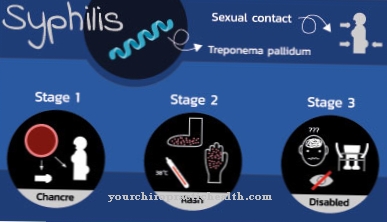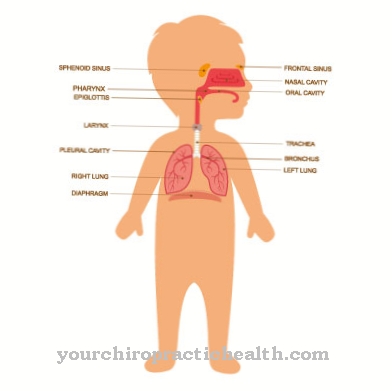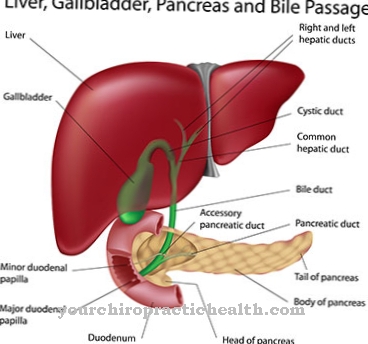At the Budd-Chiari Syndrome (BCS) it is an occlusion of the draining large hepatic vein. If left untreated, BCS is extremely painful and leads to liver failure. BCS is very rare, and more often there is an occlusion of several small hepatic veins. However, the BCS is strictly distinguished from this finding.
What is Budd-Chiari Syndrome?

© ladysuzi - stock.adobe.com
The Budd-Chiari Syndrome (BCS) is a complete occlusion of the great liver vein. BCS can be acute or chronic. In acute BCS, the occlusion occurs suddenly and leads to a rapidly deteriorating patient condition.
With a chronic course, the blood flow through the large hepatic vein is permanently impaired. The occlusion of the vein leads to blood congestion in the liver. This causes the liver to become abnormally "bloated" and as a result, the liver can no longer fulfill its functions. If the BCS is left untreated, it will lead to liver failure.
causes
There are essentially three possible causes for a BCS. Most often, there is a thrombosis - i.e. a blood clot - in the large vein, which ultimately leads to an occlusion.
In addition, a liver tumor can be the cause, which - if it is unfavorable and has reached a certain size - can occlude the vein.
Sometimes it happens that a tumor surrounds the vein from the outside and thus compresses the vein. Another possible cause for BCS is inflammation of the liver, such as chronic or acute hepatitis.
Symptoms, ailments & signs
In the worst case, the Budd-Chiari Syndrome can lead to the death of the person concerned. Usually this occurs when the syndrome is not treated. Those affected primarily suffer from very severe pain in the lower part of the abdomen. There is a strong feeling of pressure in the upper abdominal area.
As a result, the quality of life of the person affected is considerably reduced and restricted. The Budd-Chiari syndrome also leads to the development of ascites. The spleen and liver also enlarge as the disease progresses, which can lead to severe pain. If there is no treatment, nausea, diarrhea and vomiting occur.
The water retention in the abdomen can also be associated with severe pain.Subsequent liver failure causes the affected person to eventually die of Budd-Chiari syndrome. The severe pain can also lead to a loss of consciousness or even to a coma.
It cannot be predicted whether the person affected will wake up again. The Budd-Chiari syndrome often leads to severe psychological complaints in the patient or in the relatives of the person affected, so that they are dependent on psychological treatment.
Diagnosis & course
Based on the typical course of a BCS or an impending liver failure, a doctor can make a corresponding diagnosis quickly and precisely. He will ask the patient about possible causes (e.g. the presence of an inflammation) and palpate the abdomen. If the suspicion of BCS is confirmed, the doctor will perform a sonography (ultrasound examination) and - if necessary - get a more detailed picture of the occlusive foci using liver venography.
Acute BCS is very painful. Almost immediately after the vein is closed, severe pain occurs in the area of the right upper abdomen, often accompanied by a strong feeling of pressure throughout the abdomen. Vomiting and severe nausea are also side effects. Later on, water may be retained in the abdomen (ascites).
The condition of a patient with acute BCS worsens dramatically within a short period of time. The condition can lead to a coma and is often life-threatening. The doctor speaks of a chronic outflow disorder when the blood outflow via the hepatic vein is permanently impaired, but not completely interrupted or occurs constantly.
The consequence of chronic BCS is usually a pathologically enlarged liver, which leads to liver cirrhosis.
When should you go to the doctor?
In the event of severe abdominal pain and other signs that indicate a serious disease of the internal organs, a doctor must be consulted immediately. Budd-Chiari syndrome worsens rapidly, so prompt treatment is vital. At the latest when water retention in the abdomen is added to the typical symptoms, a doctor's visit is necessary. If the person concerned falls into a coma, the emergency doctor must be alerted immediately.
Severe vomiting and severe pain are also best treated by emergency services. Patients with chronic or acute hepatitis or liver inflammation are particularly at risk. People who suffer from thrombosis or other diseases of the blood vessels and veins, or who have a liver tumor, should also go to their doctor at the first symptoms.
Further contacts are specialists for internal medicine or a specialist for venous diseases. After the diagnosis, it may be necessary to go to a specialist clinic where a liver transplant is performed. Due to the risk of relapse, regular check-ups with the responsible doctor are indicated after treatment.
Doctors & therapists in your area
Treatment & Therapy
To restore optimal blood flow through the large hepatic vein, the doctor will first try to resolve the thrombosis with medication (thrombolysis) if there is a BCS.
If this does not succeed, the insertion of a shunt can be considered. To put it simply, a shunt is used to bypass the occlusive focus by means of a "diversion". There is also the option of removing the closure using a surgical technique specially tailored to the particular situation. If BCS is chronic, i.e. if the large hepatic vein is blocked frequently, the liver is permanently damaged.
To prevent this, the doctor will prescribe a drug to prevent blood clotting (such as Marcumar). If this does not work either, or if a patient suffers from the side effects of the medication over the long term, a liver transplant may be indicated.
Outlook & forecast
Budd-Chiari syndrome must be treated in any case. This disease does not heal itself and the person concerned will continue to die if no treatment is initiated. Usually the patient then dies due to liver failure.
The syndrome is also associated with very severe pain if there is no treatment. During treatment, medication is primarily administered to alleviate the symptoms. However, if these do not have any effect, the patients are dependent on a shunt to alleviate the symptoms.
If the disease is chronic, the liver will be irreversibly damaged and the patient will die. After all, a liver transplant is necessary to keep the person affected. However, this can also lead to severe side effects and various complications, so that a general course of the disease cannot be given.
In many cases, however, the prognosis for Budd-Chiari syndrome is relatively poor, which means that life expectancy is reduced. An early diagnosis of Budd-Chiari syndrome always has a positive effect on the further course of the disease.
prevention
BCS can only be prevented to a limited extent. Patients who are prone to developing BCS due to a previous illness - such as a tendency to thrombosis, a tumor or hepatitis - should have regular check-ups.
If there is a risk of developing chronic BCS, prophylactic use of an anti-coagulant can be considered. It is also advisable not to put unnecessary strain on the liver, for example through excessive consumption of alcohol or medication.
Aftercare
Follow-up care for Budd-Chiari syndrome is only possible in rare cases. The disease is primarily treated first with the help of medication, so that these must be taken regularly. Possible interactions with other medications should also be checked and discussed with a doctor.
If the drug treatment does not bring the desired success, the Budd-Chiari syndrome must be treated with a surgical procedure. In some cases, however, the affected person's liver is already so badly damaged that the patient will die if a transplant cannot be performed.
After a transplant, the liver must be monitored continuously to avoid complications. The patient has to be prepared for a longer stay in a hospital. Wound healing must also be promoted. Unnecessary exertion or sporting activities should be avoided. The patient must follow a healthy lifestyle with a healthy diet.
You should completely avoid alcohol and nicotine. In most cases, the patient's life expectancy is significantly reduced despite treatment for Budd-Chiari syndrome. Even after successful treatment, the patient is dependent on taking medication and regular medical examinations.
You can do that yourself
People diagnosed with Budd-Chiari syndrome require extensive medical treatment in the first place. Medical therapy can be supported by various self-help measures and the use of alternative means from naturopathy.
First of all, the person concerned should observe strict personal hygiene. Since shunts are usually set in Budd-Chiari syndrome, there is an increased risk of infection. Regular washing is all the more important, especially in the affected area. Moderate outdoor exercise and a healthy diet can further aid recovery.
If the affected area shows signs of inflammation, the doctor must be informed immediately. The doctor will usually also recommend rest and bed rest to the patient. Sufficient rest is particularly important in the first few weeks and months, as the disease can put a heavy strain on the body and mind.
In order to avoid emotional complaints, a therapist should be consulted during physical treatment. Patients who feel depressed or have unusual mood swings as a result of the illness are best advised to speak to their doctor. Often the symptoms can be alleviated by changing the medication, but in some cases further treatment by a therapist or psychotherapist is indicated.

.jpg)



.jpg)


















.jpg)



